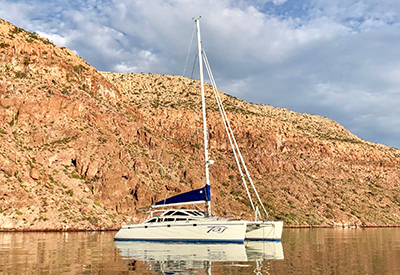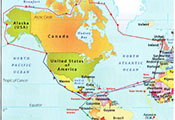CYOB Inbox: Solar power – Nerds of a feather

Feb 25, 2021
Last issue, Mike Wheatstone, our Boat Nerd started a conversation about solar power. While many of you were engaged with the article, one reader took the discussion a whole lot further. Here’s the exchange for your continuing in-depth interest in the topic:
Hi Mike,
We have a 48 ft. Grainger cat on Saltspring Island B.C. with 3 older 150 wt panels and 2 200watt Renogy flexible panels. I see in the Vendee that a lot of the boats have fixed panels right on their decks that they walk on. Do these last, and are they inefficient, flexible, just glued down?
I’d like to make more solar and have a sizable MPPT controller and 900 amp hrs of AGM batteries, but in the shoulder seasons or cloudier weather we don’t get much.
In the winter my batteries are at 100% because we have depowered everything. Is this bad? I have limited the charge to 14.2v
Any suggestions would be appreciated.
Regards,
Betsy Johnston & Derek Hill,
Salt Spring Island
Hi Derek,
Thank you for your email.
I believe the Vendee Globe boats are an example of function over all else. These vessels tend to be at the other end of the spectrum from cruising boats! VG boats have little option for power other than flexible panels fastened to the boat, the panels won’t get walked on a lot, and a long life isn’t a major requirement.
I see you have Renology flexible panels already. These are a good brand but you are dealing with plastic that will degrade more quickly than glass and aluminum. Renology also recommends not walking on the panels. Flexible panels have an efficiency of typically 7-15% vs 16-20 for mono & polycrystalline and so will be larger than an equivalent hard panel. Yes they can be fastened to the deck or above a cloth bimini.
When we bought our cat in 2012 I had an arch fabricated to hold 4 rigid panels out the back of the bimini. I see many more cats going this way to get sizable arrays (due to their wide beam), and the enhanced afternoon shade is nice! I removed the rigid panels on the bimini so I wouldn’t trip over them if fighting the main down and the boom was flopping about at all.
Yes, the farther north (or south for any friends down under) from the equator you get, the more slanted the sun’s rays become, with an attendant loss of power produced. Moving away from summer, the shorter days and increasing seasonal slant of the sun, will diminish your yield as you’ve discovered. On a smaller panel you may be able to mount it so you can angle it to better intersect the suns rays at 90 degrees.
Do you have high output alternators on your engines? They would allow you to pump significant amps into your batteries quickly when they are under 70% charged. Engine (or generator) based charging by itself is no good for bringing the batteries to full charge. Use when the batteries are most discharged and let your solar do the final topping up.
For winter on our boat in Toronto (AGM batteries), I used to leave the solar running but the past few years have just fully charged the batteries and then disconnected them totally when it gets cold in December, reconnecting them in April. The self discharge rate in cold weather is quite small
I hope this answers your questions?
Regards, Mike
Thanks very much Mike, We have Leece Neville 180 amp alternators on each engine with Balmar 3 step external regulators. Of course the 1st alternator charging does all the work while the other coasts along. The original Hitachi 80 amp alternators still are there but only charge the starting battery. In winter Mexican sun with the two Renology flexible and the 3 fixed we could get as high as 29 amps, but more often about 20 with high sun. Here in B.C. we can get that for a brief period in the summer days but not in October.
We do use our boat every month and I detune the solar controller to 13.8 v so as not to over charge the AGM.
We are really trying to reduce our carbon footprint, and I have seen the online cruiser videos where they are pulling out their propane stove tops and oven and going to induction burners and toaster ovens. That is great for the South Pacific but unless we could have lots of solar panels we’d have to run the engines a lot to get the charge we need particularly when running two diesel heating units, one in each hull.
On our last boat a Beneteau 473 we had one 310 watt panel on a pole at the swim grid so we could rotate and tip with just loosening one handle. In high winds we’d just set it flat and it worked well. But on Taj we launch our inflatable from the stern using a gantry that comes out of the boom and the main halyard, so the ideal big arch won’t work. That’s why I was hoping there were better flexible panels that would last on the deck.
Thanks very much for your input.
Derek
Hi Derek,
Small world, my wife had an uncle with a cottage on Saltspring Island.
Ah I understand your setup better now. Thanks also for the picture of Taj. Yes the boats going totally electric tend to do it with largish lithium battery banks (600-1000Ah) and at least 1-2K of solar.
I am surprised, that in summer sun especially if down south, you aren’t seeing closer to 50+ amps from your panels. Are the specs for the two types of panels close? Are they all on one controller and do you suffer from much shade on a panel? I get 20+ amps at summer peak in Toronto from a single 300W panel on our Hunter.
I understand your desire to reduce your carbon footprint. Have you thought about panels hinging off your side lifelines that could swing up? I’ve seen Stainless pipe slid over the lifelines and rigid panels attached to them.
Do you have deck space for more flex panels where they won’t be trod on normally? Sorry, other than a couple of friends who run 200W of flex panels above their cloth biminis I don’t have lots of direct flex panel experience.
If you do add more panels you may want to consider multiple smaller MPPT controllers to optimize your power generation.
I didn’t see a mention of the size of your AGM bank. If 400Ah or less one of your high output alternators is probably about all it can take when discharged. If larger you may want to consider a Centrefielder from Balmar to make both alternators load share and increase charging amps or a new external regulator setup from Wakespeed or Electromaax. That would also set you up if you wanted to go lithium.
If you leave you solar connected, floating at 13.4V will not overcharge the battery, however you should periodically do an absorption cycle at 14.4V (or whatever your battery manufacture recommends, or if Lifeline brand perhaps an equalization charge) to ensure you don’t get sulfating on the battery plates.
Regards,
Mike





























